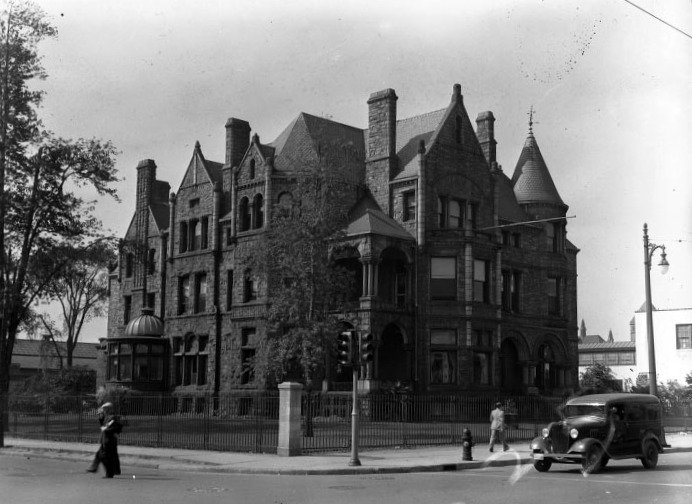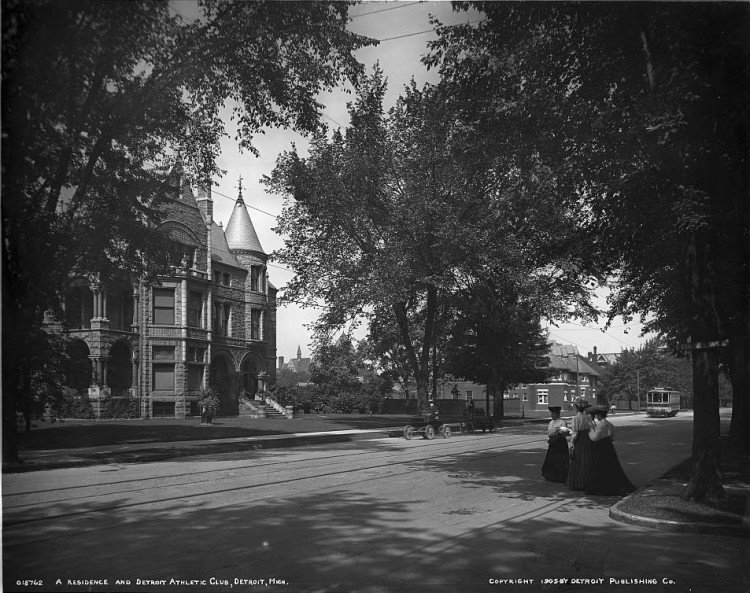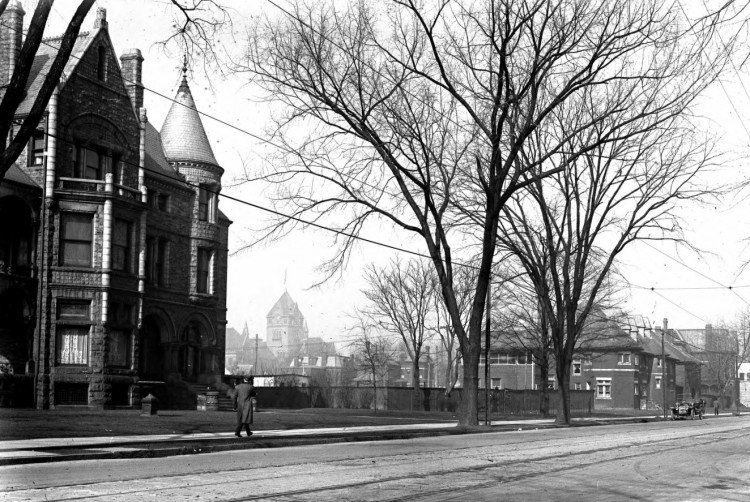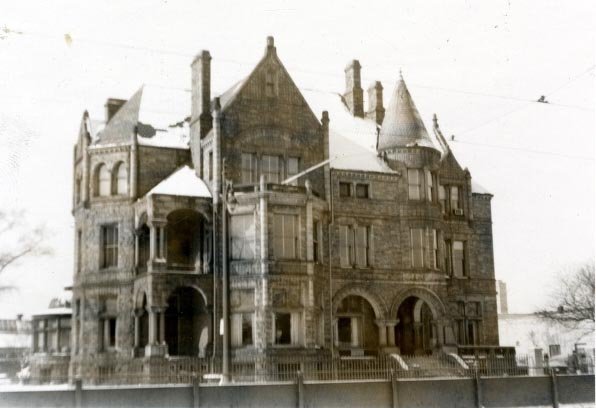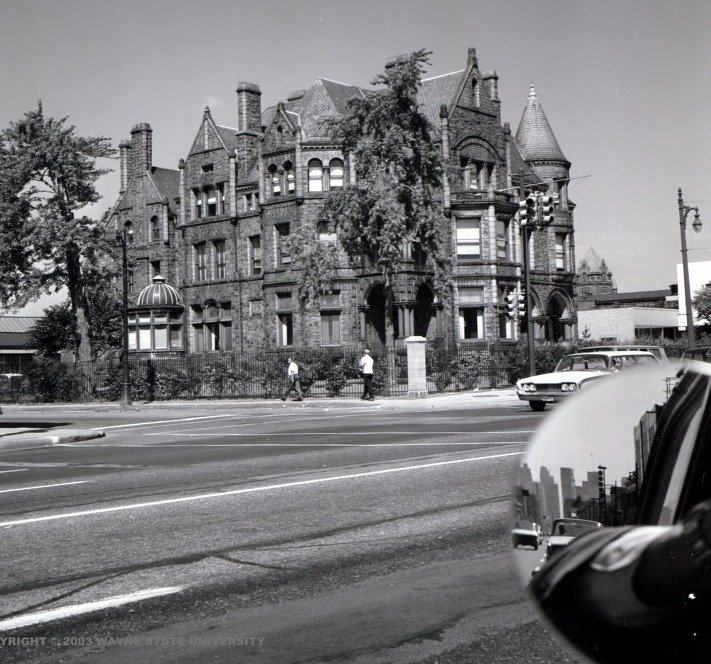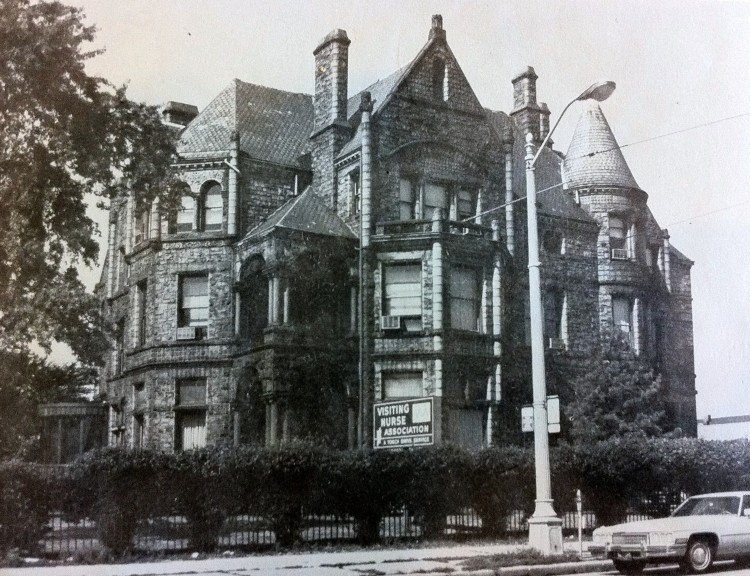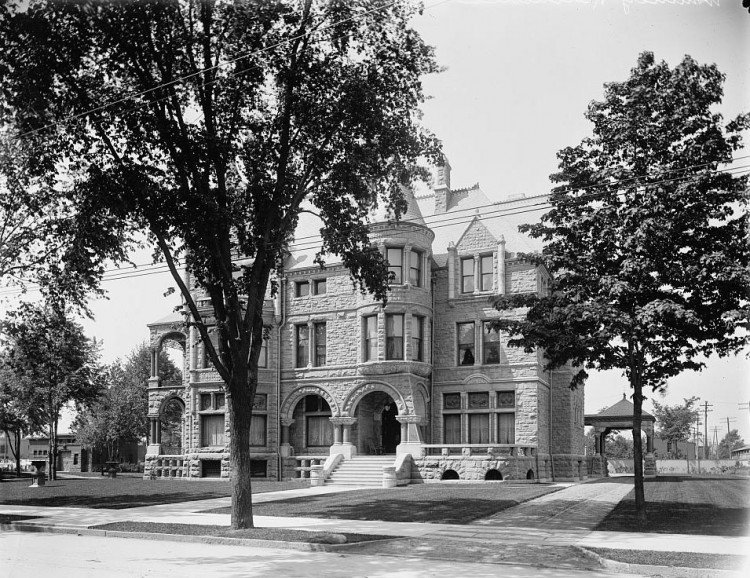HISTORY
of Detroit’s Most Iconic Mansion
Originally the home of David C. Whitney JR and Sara Whitney, The Whitney mansion is now world famous for upscale dining in Detroit. Completed in 1894, this Motor City landmark retains the exquisite charm of Detroit’s early upper echelon as a venue for all to enjoy.
Each has it’s own unique appeal that guests come specifically to enjoy and sometimes find themselves wandering, spending hours frolicking in the enchantments of the estate.
Original Owners: David C. Whitney Jr and Sara Whitney
Construction: 1890-1894
Architect: Gordon W. Lloyd
Style: Romanesque Revival
Estimated Cost: $400,000 (USD circa 1894)
Statistics
Original Furnishings: $250,000 (USD circa 1894)
Original Artwork: $300,000 (USD circa 1894)
Square Footage: 22,000
Rooms: 52
Bathrooms: 10
Fireplaces: 20
Windows: 218
Exterior: Granite
Roof: Slate
HISTORY
The David Whitney Jr. House was built by successful lumber baron David Whitney Jr., one of Michigan’s wealthiest citizens and the wealthiest man in Detroit. He was worth more than $15 million at the time of his death in 1900.
David Whitney Jr. was born Aug. 23, 1830, in Watertown, Mass. He quickly established himself in the lumber trade and moved to Detroit by age 27. The company he and his brother Charles headed expanded from the eastern seaboard and Canada to Michigan, Ohio, Pennsylvania and Indiana. It was for some time the largest lumber dealer in the United States. Lumber was not Whitney’s only business venture; he also was involved in real estate speculation, steamships and banking. He wisely bought up property around Grand Circus Park when it was the far reaches of downtown business, and in 1885, he built the five-story Grand Circus Park Building. It would be replaced with the much larger David Whitney Building, designed by the world-renowned architect Daniel Burnham, in 1914. Whitney married Flora McLaughlin in 1860 and had one son – David C. Whitney - and three daughters, Flora Ann Whitney Demme, Katherine Whitney McGregor, and Grace Whitney Hoff (who was given, as a wedding present in 1882, a home at 79 Alfred St. that still stands today; this home was rented by retail giant Joseph L. Hudson from 1894-1904).
The Whitneys built a home on the corner of Woodward and Sproat in 1870. The home which has been attributed to Mortimer L. Smith – who designed the first Detroit Opera House - was a restrained Second Empire-style brick home with a mansard roof and heavily bracketed eaves. The home quickly seemed passe and out-of-date, especially to a family with such means, reputation and influence as the Whitneys.
“Whitney himself made it known that he would be happy living in a log cabin, but Mrs. Whitney felt otherwise,” W. Hawkins Ferry said in his seminal book “The Buildings of Detroit.” And so, in 1890, David Whitney hired architect Gordon W. Lloyd - who he had employed to design the Grand Circus Building - to build him a new, more fashionable home farther north, at Woodward and Canfield avenues.
“Mrs. Whitney must have walked over daily (to inspect the work on her new home), a picturesque figure in a full, gored, bell-shaped skirt with huge puffed sleeves,” the Detroit News said.
Lloyd was an English architect who also designed the Detroit’s Central United Methodist Church, the Wright Kay Building and University of Detroit’s Dowling Hall. The home he designed for the Whitneys was in the Romanesque Revival style, which was popular at the end of the 19th century for churches and public buildings because of its implied visual strength.
The Whitneys’ neighbors were Harvey C. Parke, of Parke Davis Pharmaceuticals, Captain E.M. Peck, Dr. Donald McLean and the old Detroit Athletic Club, which sat just north on Woodward. The proximity to the D.A.C. was no accident, as Whitney and his son were both active club members. It must been an added convienence to watch polo matches from the second and third floors of their home. The bleachers ran along the southern edge of their property line. The D.A.C. later moved to its current home on Madison Avenue, with the former site on Woodward becoming home to a Vernors ginger ale plant, a far less aristocratic neighbor for the Whitney mansion. The site is now occupied by an apartment complex called Studio One apartments that is operated by Wayne State University.
Mega mansion
Work began on the home in 1890. It was estimated to have cost $400,000 (about $9.5 million today) and was featured in several newspapers of the time. It was constructed using rose-colored South Dakota jasper, a type of granite. The Whitney mansion is 22,000 square feet and has 52 rooms (including 10 bathrooms), 218 windows, 20 fireplaces and numerous stained-glass windows crafted by Tiffany’s of New York. It was the first residential home in Detroit to have an elevator for personal use, a hydraulic number. The Whitneys spent an additional $250,000 ($6.2 million today) on decorating and furnishing the home and another $300,000 ($7.5 million today) on artwork from around the world.
The exterior of the mansion looks much like it did it 1890, thanks to the use of solid granite as the primary building material, although for a time, news articles referred to the mansion as gray instead of pink or rose because of Detroit’s early 20th century pollution. The mansion has since been cleaned, restoring its color. The rough-faced pink stone was laid in a random ashlar pattern with decorative belt courses of gray granite breaking up the heaviness of the façade. All over the home there are stone carvings of intertwining leaf motifs, grotesques and David Whitney’s initials. The roof is covered in slate tiles laid in a fish scale pattern. The Woodward Avenue elevation is a textbook example of Romanesque Revival.
A series of arches at the entrance porch spring from squat, polished granite columns with cushion capitals. A wide two-story bay window breaks up the wall and provides views up and down Woodward. A common feature of Romaneque houses is a round tower with a conical roof. The Whitney mansion’s tower begins at the second foor, above the entranceway, and continues above the third floor roof line, finishing in a decorative copper spire. At the corner of Canfield and Warren, there is a two-story balcony; each story is supported by clustered granite columns supporting a stone arch. The Canfield elevation is a less cohesive statement than the Woodward façade, with a series of gables, bays and dormers combined along the side elevation. An exotic looking conservatory with a domed roof juts out from the wall off the dining room, providing a home for the Whitneys’ plants. At the rear of the home is the carriage house that originally contained a lift that took carriages up to the second floor. It was the largest coach house in the state when it was built. Later, when the Visiting Nurse Association would acquire the carriage house for its offices, an old landau carriage with silver lanterns was still housed in the building. It is now at the Henry Ford Museum in Dearborn.
Upon entering the Woodward Avenue entrance, guests would be overwhelmed by the grand hall, the largest room in the mansion. All the main rooms of the home open to the hall, creating an enormous open space. “Mr. and Mrs. Whitney frequently entertained their many wealthy friends at receptions and teas, evening parties and musicales,” the Free Press said. The floor here is English tile laid in a Flemish mosaic design. The hall is paneled in quarter-sawn oak. The dominant features of the hall are the fireplace and the massive staircase. The fireplace overmantle is carved into a series of arches, the central arch containing a bronze clock. The bronze balustraded staircase is inset between another series of large carved arches, with its landing dominated by the two-story Tiffany window. This window depicts a bearded knight, paying homage to the various members of the Whitney family who were knighted, as well as their royal blood line in England. The 24-foot by 50-foot hall has an ornate coved frieze that is decked out in silver leaf with David Whitney’s initials appearing above the fireplace. At a 1933 reception for Whitney’s daughter Grace, Mrs. John Hoff, remembered “after breakfast the family came out to gather again around a long table in the hallway to open the morning mail.”
To the north side of the grand hall is the music room, which measures 36 feet by 23 feet with the northern-most set of stained glass windows inset into a columned alcove that is highlighted with a delicately carved maple wood screen. These Tiffany windows are of St. Cecelia, the patron saint of music, and of Apollo and his lyre. The ornate ceiling, depicting cherubs, is painted on silk. Next to the music room is Mr. Whitney’s smoking room or study. It is more somber than the music room with rich mahogany woodwork and a vaulted ceiling.
To the left of the entry, along Woodward, are the reception and drawing rooms. These rooms are done in a Neo-Classical style with the carvings and frieze depicting wreaths and swags. They were originally painted in ivory enamel with gold relief. The ornate fireplace is white onyx. The flooring is Honduras mahogany with bird’s-eye maple inlay. These rooms must have been quite cheerful with the white walls, gleaming onyx and oversize windows bringing in the morning light.
The dining room and the library occupy the south end, the Canfield side, of the mansion. The library is covered in mahogany with 7-foot high bookcases capped at the corners with decorative columns. The ceiling is crisscrossed in detailed wooden beams with pendant light fixtures at the intersections of the angular room. The 10-foot high fireplace in the library is unique with its deep blue tiles accented with sliver filigree. The dining room is also executed in mahogany.
“He knew the uses of wood, and the beautiful paneling in this house expresses his love of trees and what came out of them,” the Free Press wrote. The walls are lined with paneled mahogany. The interlacing ceiling design is crafted out of mahogany as are the sideboard and fluted columned fireplace. The fireplace surround is of African, or Numidian, marble. Hand-painted ceiling and wall panels depict handpainted fruit and pastoral scenes. Whitney bought tapestries from the legendary Gobelin Tapestry Works in Paris to line the walls and hide the secret vault that contained their valuables.
The second floor of the home contained the ballroom and various bedroom suites. The ballroom measures 41 feet by 17 feet and is bathed in light from the massive Tiffany window and connects all the adjoining bedrooms. The ballroom is wainscotted in oak and has a large central fireplace. The plaster ceiling is an ornately patterned geometic design. Mrs. Whitney’s suite of rooms opens to the corner balcony at the southeast corner of the home. The bedroom featured silver birch woodwork and mahogany accented with gold carvings in the octagonal boudoir. Mr. Whitney’s bedroom is in the northeast corner of the mansion. The remaining bedrooms belonged to the children or were guest rooms. Each bedroom was furnished in various periods and had a fireplace.
The third floor was home to the Whitneys’ art gallery, more guest rooms and small servants’ bedrooms at the rear of the home. The ceiling of the art gallery is vaulted and had a skylight. Light fixtures placed high in the curves of the ceilings gave a dramatic effect and helped illuminate the artwork.
The basement of the mansion housed a paneled billiard room and the massive heating system for the home. It is said that Thomas Edison designed some of the lighting for the Whitney mansion. A lighting expert from Detroit Edison said the 1893 lighting was “remarkable in its foresight.”
David Whitney’s first wife, Flora McLaughlin Whitney, passed away in Detroit in 1882, and one year later, he married her sister Sara. David Whitney died of a heart attack on Nov. 30, 1900, and was buried in Woodmere Cemetery. Hudson, the department store magnate, was one of the pallbearers that carried Whitney’s body from the home.
After the Whitneys
An "American Palace"
Following David Whitney’s death in 1900 - having lived in the mansion for only six years – his widow, Sara, continued to live there until her death, in 1917. From then until 1932, when the Whitney family allowed the Wayne County Medical Society to move in, only a caretaker lived in the home. The Medical Society moved in without a down payment on the residence, and the Whitney estate even paid the $15,000 a year property taxes. The Whitney family has always been an advocate of the medical profession, as the original tenants of the David Whitney Building on Grand Circus Park were mostly medical professionals, as well. As the Great Depression ended, the doctors at the Medical Society were able to take over the maintenance bills and taxes.
In 1941, the Whitney family gave the house to the Wayne County Medical Society. “It means much to us that this house filled with sacred memories is now given to such a glorious organization as the Wayne County Medical Society,” Grace Whitney said. According to Dr. A.F. Jennings, the chairman of the medical society, the “million-dollar gift was one of the most notable ever made in the country to any medical society.” The society remained in the home until 1956, when it built a more modern facility near the Wayne State University Medical Science Building. When the doctors moved out, they took with them the life-size marble statue of Psyche that sat in the music room, a bust of Venus de Milo and a bronze bust of Shakespeare.
The Visiting Nurse Association had moved its offices to the carriage house in 1929. The horse stalls were remodeled into offices for training with funds provided by Mrs. F.M. Alger. The VNA purchased the Whitney property for $150,000 with a grant from the Metropolitan Detroit Building Fund in 1957. Another $75,000 from the McGregor Fund, the private foundation started by Katherine Whitney and her husband, Tracy McGregor, in 1925. The nurses, with offices throughout the home, continued to maintain the mansion until 1979, when it was sold to entrepreneur Richard Kughn. Kughn learned that the mansion would likely be torn down after the Visiting Nurse Association left. “It should be preserved, not for personal use but so that the public can see and enjoy it,” he said.
In 1986, after a lengthy and costly restoration (about $3 million in 1986), Kughn opened The Whitney restaurant, “an American restaurant in an American palace.” He enlisted the help of John McCarthy and Ron Fox, who ran Van Dyke Place, a French restaurant in the West Village of Detroit. Fox and McCarthy enlisted crews of students from the Center for Creative Studies to help bring the painted murals back to life. A state-of-the-art kitchen was installed in the former servant’s quarters at the rear of the mansion. The dining rooms on the first and second floors were named after their original purpose and each is uniquely furnished. The third floor became a cocktail lounge named the Winter Garden. The Whitney restaurant went on to become a culinary leader in the Detroit area for many years.
The Whitney mansion changed hands again in 2007, when Kughn sold the mansion to Bud Liebler, a former Chrysler executive, for more than $2 million. He originally wanted to buy only the carriage house, but Kughn would sell it only as a package deal. Liebler shut the restaurant down for a few weeks to do some renovations, including toning down some of the 1980s paint choices, restore the wood finishes and update the menu. About $300,000 was spent outside in the garden area, where some of the overgrown landscaping was thinned out or removed. They renamed the third floor bar the Ghost Bar after tales of Whitney’s ghost haunting the building. Liebler and his son, Patrick, run their public relations firm, the Liebler Group, from the third floor of the mansion.
A prophetic statement by the Free Press in 1894 seems to summarize her best: “The Whitney place will last as long as is given to houses made by man to endure.”
Year opened 1894
Architect Gordon W. Lloyd
Style Romanesque Revival
HISTORICDETROIT.ORG
After the Whitneys
An "American Palace"
Following David Whitney’s death in 1900 - having lived in the mansion for only six years – his widow, Sara, continued to live there until her death, in 1917. From then until 1932, when the Whitney family allowed the Wayne County Medical Society to move in, only a caretaker lived in the home. The Medical Society moved in without a down payment on the residence, and the Whitney estate even paid the $15,000 a year property taxes. The Whitney family has always been an advocate of the medical profession, as the original tenants of the David Whitney Building on Grand Circus Park were mostly medical professionals, as well. As the Great Depression ended, the doctors at the Medical Society were able to take over the maintenance bills and taxes.
In 1941, the Whitney family gave the house to the Wayne County Medical Society. “It means much to us that this house filled with sacred memories is now given to such a glorious organization as the Wayne County Medical Society,” Grace Whitney said. According to Dr. A.F. Jennings, the chairman of the medical society, the “million-dollar gift was one of the most notable ever made in the country to any medical society.” The society remained in the home until 1956, when it built a more modern facility near the Wayne State University Medical Science Building. When the doctors moved out, they took with them the life-size marble statue of Psyche that sat in the music room, a bust of Venus de Milo and a bronze bust of Shakespeare.
The Visiting Nurse Association had moved its offices to the carriage house in 1929. The horse stalls were remodeled into offices for training with funds provided by Mrs. F.M. Alger. The VNA purchased the Whitney property for $150,000 with a grant from the Metropolitan Detroit Building Fund in 1957. Another $75,000 from the McGregor Fund, the private foundation started by Katherine Whitney and her husband, Tracy McGregor, in 1925. The nurses, with offices throughout the home, continued to maintain the mansion until 1979, when it was sold to entrepreneur Richard Kughn. Kughn learned that the mansion would likely be torn down after the Visiting Nurse Association left. “It should be preserved, not for personal use but so that the public can see and enjoy it,” he said.
In 1986, after a lengthy and costly restoration (about $3 million in 1986), Kughn opened The Whitney restaurant, “an American restaurant in an American palace.” He enlisted the help of John McCarthy and Ron Fox, who ran Van Dyke Place, a French restaurant in the West Village of Detroit. Fox and McCarthy enlisted crews of students from the Center for Creative Studies to help bring the painted murals back to life. A state-of-the-art kitchen was installed in the former servant’s quarters at the rear of the mansion. The dining rooms on the first and second floors were named after their original purpose and each is uniquely furnished. The third floor became a cocktail lounge named the Winter Garden. The Whitney restaurant went on to become a culinary leader in the Detroit area for many years.
The Whitney mansion changed hands again in 2007, when Kughn sold the mansion to Bud Liebler, a former Chrysler executive, for more than $2 million. He originally wanted to buy only the carriage house, but Kughn would sell it only as a package deal. Liebler shut the restaurant down for a few weeks to do some renovations, including toning down some of the 1980s paint choices, restore the wood finishes and update the menu. About $300,000 was spent outside in the garden area, where some of the overgrown landscaping was thinned out or removed. They renamed the third floor bar the Ghost Bar after tales of Whitney’s ghost haunting the building. Liebler and his son, Patrick, run their public relations firm, the Liebler Group, from the third floor of the mansion.
A prophetic statement by the Free Press in 1894 seems to summarize her best: “The Whitney place will last as long as is given to houses made by man to endure.”
Year opened 1894
Architect Gordon W. Lloyd
Style Romanesque Revival
HISTORICDETROIT.ORG
Lean & Green Michigan-19th Century Detroit Icon goes green
In August 2017, the fabulous Whitney mansion became the site of Detroit and Wayne County’s first PACE project.
Wayne County’s PACE program allowed Whitney owner Bud Liebler to transform one of the leading icons of the 19th -century Detroit opulence into a showcase of the city’s low carbon future.
The PACE project involved replacing patchwork heating and cooling systems installed many decades since the mansion’s 21 fireplaces ceased provide its heat, LED lights throughout; efficient storm enclosures on over 200 windows; building control system; and highly efficient cooking equipment.
With these energy efficiency improvements, the landmark restaurant and bar will be less costly to operate to operate, more comfortable for guests, and help lead Detroit into a new era of sustainability.
In August 2017, the fabulous Whitney mansion became the site of Detroit and Wayne County’s first PACE project.
Wayne County’s PACE program allowed Whitney owner Bud Liebler to transform one of the leading icons of the 19th -century Detroit opulence into a showcase of the city’s low carbon future.
The PACE project involved replacing patchwork heating and cooling systems installed many decades since the mansion’s 21 fireplaces ceased provide its heat, LED lights throughout; efficient storm enclosures on over 200 windows; building control system; and highly efficient cooking equipment.
With these energy efficiency improvements, the landmark restaurant and bar will be less costly to operate to operate, more comfortable for guests, and help lead Detroit into a new era of sustainability.



